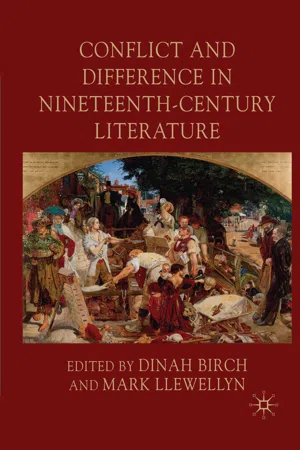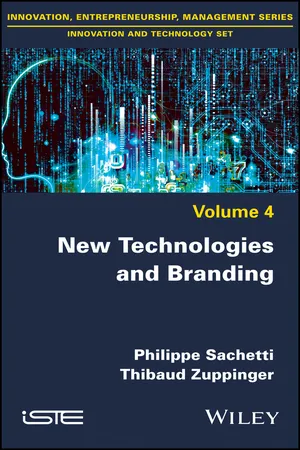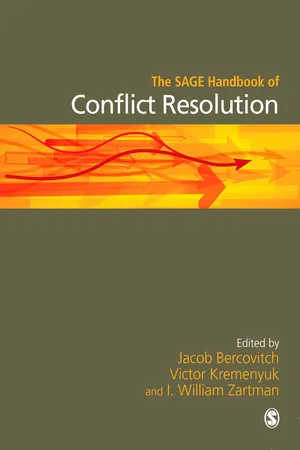Literature
Conflict
Conflict in literature refers to the struggle between two opposing forces, which can be internal or external. It is a crucial element that drives the plot and creates tension, leading to character development and resolution. Conflict can be categorized into different types, such as man vs. man, man vs. nature, man vs. society, and man vs. self.
Written by Perlego with AI-assistance
Related key terms
1 of 5
3 Key excerpts on "Conflict"
- D. Birch, M. Llewellyn, D. Birch, M. Llewellyn(Authors)
- 2010(Publication Date)
- Palgrave Macmillan(Publisher)
Mapping ‘Conflict’ and ‘difference’ in relation to such a prodigious body of work is a complex matter, for no overarching theory will contain its scope. Theories fragment or look too neat when confronted by the scale of the Victorians’ own awareness of difference as fundamental to cultural expe- rience. The perception of difference may be presented in constructive terms, as the foundation of a full recognition of the needs and the individual value of those who are not like us. But difference persistently shades into Conflict. Disagreement and division underpins the act of writing throughout the period, and the essays collected here suggest new ways of understanding the significance of these Conflicts. What provides the coherence of the dis- cussion is the focus on literary texts as the location of a productive range of encounters around these concepts. Conflicts in understanding, belief and interpretation cannot be resolved through literature but the literary can provide a space in which differences in relationships, worldview, politics, aesthetics and ethics can be made meaningful through the very assertion of difference as fundamentally an empowering action. In this sense, we are following the idea that literature has a particular claim and function in the exploration of issues that stimulate Conflict and in the interpretation of ‘difference’ within a given culture or period. Derek Attridge, in Peculiar Language: Literature as Difference from the Renaissance to James Joyce (2004), 4 Conflict and Difference in Nineteenth-Century Literature makes a similar point in writing about the function of literature as it grows from Romantic inwardness into modernist diversity.- eBook - ePub
- Philippe Sachetti, Thibaud Zuppinger(Authors)
- 2018(Publication Date)
- Wiley-ISTE(Publisher)
2.2. What is a Conflict?
If we follow what is indicated by its etymology, Conflict is a moment of imbalance between two forces. By defining it as such, we then need to distinguish it from violence and hostility.Conflict is the breakdown of a state of hostility by any one of the parties that begins to take action.“In actual fact, it is the causes of Conflict – hatred and envy, misery and lust – that are truly the elements of dissociation. Once Conflict has erupted for one of these reasons, it is in fact a movement of protection against the separating dualism” [SIM 15, pp. 19–20].A crisis that starts a Conflict is therefore not an accident. It proceeds from a decision to break from the status quo, and an intention to make a lasting or definitive change to the context that created it. Conflict progresses like many diseases by alternating between periods of malignancy or crisis (where the signs of hostility are paroxysmal) and periods of calm or remission.If the events that gave rise to the Conflict do not disappear completely, the Conflict will not go away. Therefore, a Brand that is drawn into a Conflict cannot hope to muzzle its critics forever. At most, it can eliminate the causes of the Conflict, change its practices or soften its positions, appease its assailants, etc., but it cannot be certain that the Conflict will not re-emerge if nothing is changed at the end of a period of crisis.Conflicts are primarily based on a question of dynamics. Pointing out a simple situation of contrast is not enough when talking about Conflict. We would then simply remain in a stage of latent hostility. The mere existence of a difference is not a Conflict. A simple contrast or opposition of values is not a Conflict.2.3. When is there a Conflict?
- eBook - PDF
- Jacob Bercovitch, Victor Kremenyuk, I William Zartman, Jacob Bercovitch, Victor Kremenyuk, I William Zartman(Authors)
- 2008(Publication Date)
- SAGE Publications Ltd(Publisher)
Indeed, the very presence of Conflict is at the heart of all human societies. This being the case, it is hardly surprising to note that “Conflict is a theme that has occupied the thinking of men more than any other, save only God and love” (Rapoport, 1960: 12). The notion that it can be eliminated is idealistic and unreal, in general, although it may be applicable to specific instances. What can be eliminated (even if it should not, in some selected cases) is the violent expression of Conflict, in the first definition. Further, in some cases, the possibility of resorting to violence, as threat or coercion, may be a necessary 4 THE SAGE HANDBOOK OF Conflict RESOLUTION adjunct to de-escalation, and of course it is useless as a threat if its implementation is inconceivable or incredible. That is one of the many fine lines in the subject. One school of thought identifies it as a psychological state of affairs, a particular situation “in which the parties are aware of the incompatibility of potential future positions” (Boulding, 1962: 5). Conflict is thus seen as a situation in which the parties perceive goal incompatibility, but do not necessarily engage in behaviour which is mutually incompatible. The idea that Conflict refers to a cognitive rather than a behavioural state is supported by Stanger (1956; 1967) and Hammond (1965). Such a conception leads to an examination of attitudes in Conflict, hostility, emotional orientations, perceptual conditions and other psychological processes (e.g. cognitive rigidity) which are brought out in a Conflict. Of course, parties can find themselves holding incompatible positions and let it go at that. But once they move from that passive or static position and start expanding efforts to prevail, active Conflict begins: escalation is dynamic Conflict. The term Conflict is derived from the Latin word confligere where it means to strike together.
Index pages curate the most relevant extracts from our library of academic textbooks. They’ve been created using an in-house natural language model (NLM), each adding context and meaning to key research topics.


